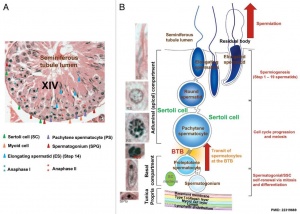Smooth Muscle Development
| Embryology - 27 Apr 2024 |
|---|
| Google Translate - select your language from the list shown below (this will open a new external page) |
|
العربية | català | 中文 | 中國傳統的 | français | Deutsche | עִברִית | हिंदी | bahasa Indonesia | italiano | 日本語 | 한국어 | မြန်မာ | Pilipino | Polskie | português | ਪੰਜਾਬੀ ਦੇ | Română | русский | Español | Swahili | Svensk | ไทย | Türkçe | اردو | ייִדיש | Tiếng Việt These external translations are automated and may not be accurate. (More? About Translations) |
Introduction
There are 3 different types of muscle: skeletal, cardiac and smooth. This page describes smooth muscle development, descriptions of cardiac muscle and smooth muscle development can be found in other notes. A specialised type of type of smooth located in glandular epithelium are myoepithelial cells.
- Smooth muscle is mesoderm, and also neural crest, in origin and contributes to many different tissues including the muscular wall of the gastrointestinal tract, respiratory tract, artery walls, bladder wall, uterus, seminiferous tubules and ductus deferens.
- Smooth muscle is non-striated in appearance, lacking the regular organisation of sarcomeres seen in skeletal and cardiac muscle.
- Gastrointestinal tract
- Cardiovascular - Blood vessel and lymphatic vessel walls.
- Renal - Urinary bladder
- Genital - Uterus, Male and female reproductive tracts
- Respiratory tract
- Integumentary - erector pili of skin
- Sensory - ciliary muscle and iris of the eye
- Smooth Muscle Links: Smooth Muscle Development | Smooth Muscle Histology | Blood Vessel | Uterus | Urinary Bladder | Mesoderm
Some Recent Findings
|
| More recent papers |
|---|
|
This table allows an automated computer search of the external PubMed database using the listed "Search term" text link.
More? References | Discussion Page | Journal Searches | 2019 References | 2020 References Search term: Smooth Muscle Embryology <pubmed limit=5>Smooth Muscle Embryology</pubmed> |
Gastrointestinal Tract
The gastrointestinal tract consists of two thick outer muscle layers (longitudinal and circular) and a thin muscularis mucosa layer.
Neural Innervation
- 1857 Meissner was the first to describe a nerve plexus in the submucosa of the bowel wall.
- 1864 Auerbach described the myenteric plexus between the longitudinal and circular muscle layers.
- 1981 LeDouarin describes neural crest contribution to both plexuses.
Myenteric Plexus
- Auerbach's Plexus
- functions for peristalsis and gastric mixing.
- Coordinated waves of descending inhibition followed by waves of descending excitation
- + Extrinsic parasympathetic cholinergic nerves (vagal and sacral) excite peristalsis and stimulate
- - Sympathetic noradrenergic nerves inhibit the transit of gut contents
Submucosal Plexus
- Meissner's Plexus
- functions for secretion and absorption.
Interstitial cells of Cajal
- Interstitial cells of Cajal (ICCs) are peripheral nervous system neuron found in some smooth muscle organs.
- function as pacemaker cells, neuromodulation or mechanosensory roles.
Peritubular Myoid Cell Layer
The contractile cell layer (myoid cell layer) found in all mammalian species located in the testis surrounding the seminiferous tubule. Their contractile activity aids spermatozoa and fluid movement in the tubule. These cells lie in the tunica propria outside the basement membrane and type I collagen layer and beneath a lymphatic layer. The organisation of this layer varies between species several cellular layers in human and some other animals, a single cell layer in rodents (rats, hamsters and mice).[5]
The term term "peritubular cells" is also used to describe the fibroblast cells found associated with capillaries in the kidney glomerulus. These are different cells.
Cardiovascular
Vascular Smooth Muscle Cells
Vascular smooth muscle cell (VSMC) progenitors are recruited into the early developing blood vessels. These progenitors have various embryonic origins (see review[1]) including:
- splanchnic mesoderm (e.g. aorta)
- somitic mesoderm (e.g. aorta)
- neural crest (e.g. pharyngeal arch arteries)
- mesothelia (e.g. trunk vasculature)
- other
Histology Images
- Smooth Muscle Histology: Labeled Colon low | Labeled Colon high | Colon x40 | Colon x40 | Ileum x10 | Oesophagus x10 | Seminiferous tubule x40 | Uterus myometrium x10 | Uterus myometrium x40 |
References
Reviews
<pubmed>25546231</pubmed>
Search PubMed
Search Pubmed Central Images: smooth muscle
Search Pubmed: Smooth Muscle Development
Additional Images
Terms
External Links
External Links Notice - The dynamic nature of the internet may mean that some of these listed links may no longer function. If the link no longer works search the web with the link text or name. Links to any external commercial sites are provided for information purposes only and should never be considered an endorsement. UNSW Embryology is provided as an educational resource with no clinical information or commercial affiliation.
Glossary Links
- Glossary: A | B | C | D | E | F | G | H | I | J | K | L | M | N | O | P | Q | R | S | T | U | V | W | X | Y | Z | Numbers | Symbols | Term Link
Cite this page: Hill, M.A. (2024, April 27) Embryology Smooth Muscle Development. Retrieved from https://embryology.med.unsw.edu.au/embryology/index.php/Smooth_Muscle_Development
- © Dr Mark Hill 2024, UNSW Embryology ISBN: 978 0 7334 2609 4 - UNSW CRICOS Provider Code No. 00098G













